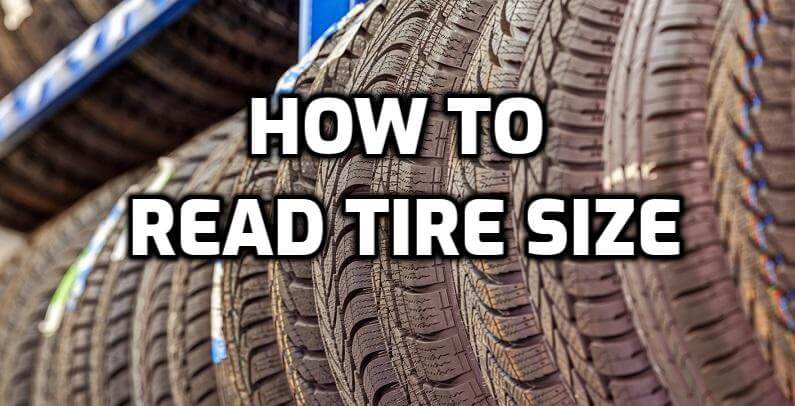How To Read Tire Size Numbers

Understanding tire size numbers is crucial for vehicle owners and drivers as they directly impact vehicle performance, safety, and fuel efficiency. Knowing how to read these numbers will help you choose the right tires for your vehicle and ensure optimal driving conditions. We will explain the components of tire size numbers and explore additional markings that provide essential information about your tires.
Understanding Tire Size Numbers
Tire size numbers are usually displayed on the sidewall of a tire and follow a specific format. For example, P215/65R15 95H. Let’s break down this format to understand what each component signifies.
Tire Class
The first letter in the tire size number indicates the tire class. In our example, “P” stands for passenger vehicles, which include cars, minivans, and SUVs.
Other tire classes include “LT” for light trucks, “T” for temporary spares, “ST” for special trailers, and Euro-metric sizes that don’t have a letter prefix.
Tire Width (215mm)
The next three-digit number (215) represents the tire width in millimeters. It measures the distance between the outer sidewalls of an inflated tire without any load. A wider tire provides better traction and stability, while a narrower tire can be more fuel-efficient and responsive.
Aspect Ratio (65%)
Following the tire width is the aspect ratio, expressed as a percentage. In our example, the aspect ratio is 65%. This number represents the ratio of the tire’s sidewall height to its width. A lower aspect ratio means a shorter sidewall, resulting in a stiffer tire with better handling but a harsher ride.
Radial Construction (R)
The “R” in the tire size number indicates radial construction, the most common type of tire construction today. Radial tires have layers of fabric and steel belts running perpendicular to the direction of travel, providing better traction, longer tread life, and improved fuel efficiency compared to bias-ply tires.
Wheel Diameter (15 inches)
The two-digit number following the construction type (15 in our example) represents the wheel diameter in inches. This number is essential as it must match your vehicle’s wheel size. Using an incorrect wheel diameter can lead to poor handling, increased tire wear, and potential safety issues.
Load index (95)
The load index is a two- or three-digit number that indicates the maximum load-carrying capacity of a tire. In our example, the load index is 95, corresponding to a maximum load of 1,521 pounds (690 kg) per tire. Choosing a tire with the appropriate load index for your vehicle is vital to ensure safety and performance.
Speed Rating (H)
The final letter in the tire size number is the speed rating, which indicates the maximum speed a tire can safely maintain under its specified load capacity. In our example, “H” corresponds to a maximum speed of 130 mph (210 km/h). Always choose a tire with a speed rating suitable for your driving needs and follow the manufacturer’s recommendations.
Additional Markings
Besides the tire size number, other markings on a tire’s sidewall provide valuable information about safety standards, performance, and manufacturing details.
DOT & Safety Standards
Tires sold in the United States must display the “DOT” (Department of Transportation) symbol, followed by a series of letters and numbers that provide information about the tire manufacturer, plant, and production date.
Other Grades
These three grades, often found together, give insight into a tire’s performance characteristics. Treadwear is a relative rating that compares a tire’s expected wear life to a standard reference tire. A higher treadwear rating indicates a longer-lasting tire.
Traction grades (AA, A, B, or C) represent a tire’s ability to stop on wet surfaces, with AA being the highest grade. Temperature grades (A, B, or C) indicate a tire’s ability to dissipate heat under high-speed conditions, with A being the highest grade.
Manufacturing Date
The manufacturing date, also known as the tire’s “birthdate,” is a four-digit code that indicates the week and year of production. For example, “3121” would signify that the tire was manufactured during the 31st week of 2021.
UTQG Rating
The UTQG rating, mandated by the U.S. Department of Transportation, provides consumers with standardized information on tire performance in three areas: treadwear, traction, and temperature resistance. UTQG ratings can be helpful when comparing similar tires, but remember that these ratings are based on controlled tests and may not perfectly represent real-world performance.
Conclusion
Understanding how to read tire size numbers and additional markings on a tire’s sidewall is crucial for choosing the right tires for your vehicle. Proper tire size ensures safety, optimal performance, and fuel efficiency.
By considering factors such as tire class, width, aspect ratio, construction, wheel diameter, load index, speed rating, and other essential markings, you’ll be well-equipped to make informed decisions about your vehicle’s tires. Always consult your vehicle owner’s manual and follow the manufacturer’s recommendations for the best tire selection.

